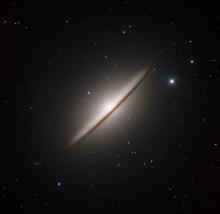Listen to today's episode of StarDate on the web the same day it airs in high-quality streaming audio without any extra ads or announcements. Choose a $8 one-month pass, or listen every day for a year for just $30.
You are here
Dark Mergers
Mergers between big galaxies are violent events. They can kick millions or billions of stars into intergalactic space, and dramatically alter the orbits of other stars. They can trigger the birth of millions of new stars — many of which will quickly blast themselves to bits. And they can result in the merger of two supermassive black holes — creating one of the brightest objects in the universe.
Most big galaxies have giant black holes in their cores. The one at the heart of the Milky Way, for example, is about four million times the mass of the Sun. And the black holes in other galaxies can be billions of times the Sun’s mass.
When two galaxies with such giant black holes come together, the black holes fall toward each other. They can stage a cosmic “dance” that lasts for hundreds of millions of years. As they loop around each other, they emit gravitational waves, causing them to move closer together.
As the black holes spiral closer, they stir up giant clouds of gas and dust. Some of this material is funneled toward the black holes. As it moves closer, it’s heated to millions of degrees. That creates a quasar — one of the more brilliant objects in all the universe.
The fireworks might not end when the black holes finally merge. Instead, the combined black hole might be kicked out of the merging galaxies. It can drag stars and gas clouds along with it — creating one final round of pyrotechnics as it heads for intergalactic space.
Script by Damond Benningfield






